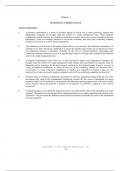Chapter 1
BUSINESS COMBINATIONS
Answers to Questions
1 A business combination is a union of business entities in which two or more previously separate and
independent companies are brought under the control of a single management team. Three situations
establish the control necessary for a business combination, namely, when one or more corporations become
subsidiaries, when one company transfers its net assets to another, and when each combining company
transfers its net assets to a newly formed corporation.
2 The dissolution of all but one of the separate legal entities is not necessary for a business combination. An
S
example of one form of business combination in which the separate legal entities are not dissolved is when
one corporation becomes a subsidiary of another. In the case of a parent-subsidiary relationship, each
R
combining company continues to exist as a separate legal entity even though both companies are under the
control of a single management team.
VE
3 A business combination occurs when two or more previously separate and independent companies are
brought under the control of a single management team. Merger and consolidation in a generic sense are
frequently used as synonyms for the term business combination. In a technical sense, however, a merger is
a type of business combination in which all but one of the combining entities are dissolved and a
IE
consolidation is a type of business combination in which a new corporation is formed to take over the
assets of two or more previously separate companies and all of the combining companies are dissolved.
H
4 Goodwill arises in a business combination accounted for under the acquisition method when the cost of the
investment (fair value of the consideration transferred) exceeds the fair value of identifiable net assets
acquired. Under GAAP, goodwill is not amortized for financial reporting purposes and will have no effect
AC
on net income, unless the goodwill is deemed to be impaired. If goodwill is impaired, a loss will be
recognized.
5 A bargain purchase occurs when the acquisition price is less than the fair value of the identifiable net assets
M
acquired. The acquirer records the gain from a bargain purchase as an ordinary gain during the period of the
acquisition. The gain equals the difference between the investment cost and the fair value of the identifiable
net assets acquired.
EA
R
D
Copyright © 2018 Pearson Education, Inc.
1-1
,1-2 Business Combinations
SOLUTIONS TO EXERCISES
Solution E1-1
1 a
2 b
3 a
4 d
Solution E1-2 [AICPA adapted]
1 a
Plant and equipment should be recorded at the $220,000 fair value.
S
2 c
R
Investment cost $1,600,000
VE
Less: Fair value of net assets
Cash $ 160,000
Inventory 380,000
Property and equipment — net 1,120,000
Liabilities (360,000) 1,300,000
Goodwill
IE $ 300,000
H
Solution E1-3
Stockholders’ equity — Pop Corporation on January 3
AC
Capital stock, $10 par, 600,000 shares outstanding $ 6,000,000
Other paid-in capital
[$400,000 + $3,000,000 – $10,000]
M
3,390,000
Retained earnings [$1,200,000 - $20,000] 1,180,000
EA
Total stockholders’ equity $10,570,000
Entry to record combination
Investment in Son 6,000,000
R
Capital stock, $10 par 3,000,000
Other paid-in capital 3,000,000
D
Investment expense 20,000
Other paid-in capital 10,000
Cash 30,000
Check: Net assets per books (book value) $ 7,600,000
Goodwill and write-up of assets 3,000,000
Less: Expense of direct costs
(20,000)
Less: Issuance of stock
(10,000)
$10,570,000
Copyright © 2018 Pearson Education, Inc.
,Chapter 1 1-3
Solution E1-4
Journal entries on Pam’s books to record the acquisition
Investment in Sun 10,200,000
Common stock, $10 par 4,800,000
Additional paid-in capital 5,400,000
To record issuance of 480,000 shares of $10 par common stock with a fair
value of $10,200,000 for the common stock of Sun in a business
combination.
Additional paid-in capital 60,000
Investment expenses 180,000
Other assets (or Cash) 240,000
S
To record costs of registering and issuing securities as a reduction of paid-
in capital, and record direct and indirect costs of combination as
R
expenses.
VE
Current assets 4,400,000
Plant assets 8,800,000
Liabilities 1,200,000
Investment in Sun 10,200,000
Gain from bargain purchase 1,800,000
IE
To record allocation of the $10,200,000 cost of Sun Company to identifiable
assets and liabilities according to their fair values, and the gain
from the bargain purchase,computed as follows:
H
Cost $10,200,000
Fair value of net assets acquired 12,000,000
Bargain purchase amount $ 1,800,000
AC
M
EA
R
D
Copyright © 2018 Pearson Education, Inc.
, 1-4 Business Combinations
Solution E1-5
Journal entries on the books of Pop Corporation to record merger with Son
Corporation
Investment in Son 1,060,000
Common stock, $10 par 360,000
Additional paid-in capital 300,000
Cash 400,000
To record issuance of 36,000 common shares and payment of cash in the
acquisition of Son Corporation in a merger.
Investment expenses 140,000
Additional paid-in capital 60,000
S
Cash 200,000
To record costs of registering and issuing securities and additional
R
direct costs of combination.
VE
Cash 80,000
Inventories 200,000
Other current assets 40,000
Plant assets — net 560,000
Goodwill 320,000
Current liabilities
Other liabilities
Investment in Son
IE 60,000
80,000
1,060,000
H
To record allocation of cost to assets received and liabilities assumed
on the basis of their fair values and to goodwill computed as follows:
AC
Cost of investment $1,060,000
Fair value of net assets acquired 740,000
Goodwill $ 320,000
M
Solution E1-6*
Net assets (+A) 2,200
Common stock (+SE) 1,200
EA
Additional paid-in capital (+SE) 800
Retained earnings (+SE) 200
Expenses (E, -SE) 60
Cash (-A) 60
R
D
Solution E1-7*
Net assets (+A) 2,100
Capital stock (+SE) 1,470
Retained earnings (+SE) 600
Investment in Sun Corporation (-A) 30
Copyright © 2018 Pearson Education, Inc.




